Space pictures! See our space image of the day
In a galaxy far, far away...
Space can be a wondrous place, and we've got the pictures to prove it! Take a look at our favorite space pictures here, and if you're wondering what happened to today in space history don't miss our On This Day in Space video show here!
In a galaxy far, far away...
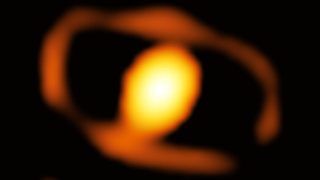
Thursday, November 21, 2024: Astronomers have captured a "zoomed-in" image of a star outside the Milky Way for the first time. The team brought the vast red supergiant star designated WOH G64 into focus using the Very Large Telescope Interferometer (VLTI).
WOH G64 is located a staggering 160,000 light-years away in the Large Magellanic Cloud (LMC), a satellite dwarf galaxy companion of the Milky Way. Astronomers have known of the existence of this star for some time, and it has earned the nickname the "behemoth star" because it is an incredible 2,000 times the size of the sun. — Robert Lea
Read more: Star imaged in detail outside the Milky Way for the 1st time (image, video)
Awash in aurora
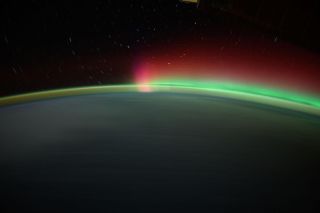
Wednesday, November 20, 2024: Another beautiful aurora photo, shot from the International Space Station. From NASA's recent photo archives, "star trails, an aurora, and Earth's atmospheric glow highlight this long-duration photograph taken from the International Space Station as it orbited 259 miles above the North Pacific Ocean."
Starlinks flashing ISS
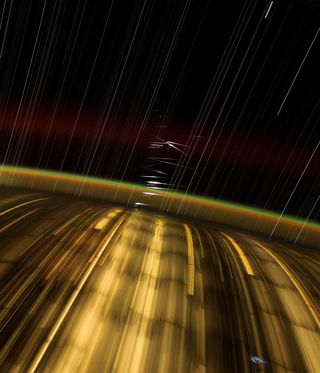
Tuesday, November 19, 2024: "Starlink satellites look like a miniature version of the monolith from '2001: A Space Odyssey,' where the large flat face of the monolith points towards Earth and the solar panel protrudes outward like the fin on the back of a dimetrodon," wrote NASA astronaut Don Pettit in a post on X, after snapping this long exposure photo from the International Space Station.
He describes the image in the post, saying, "compared to the well-defined streaks from star trails, this time exposure shows wonky streaks flashing ISS. These are Starlink satellites reflecting pre-dusk or pre-dawn sunlight off their solar panels. They are only seen from 5 to 18 degrees preceding or trailing the sun. They create bright flashes, perhaps lasting for a few seconds each due to the orientation of their outward pointing solar panels."
Read more: SpaceX Starlink satellites seen as ‘wonky streaks’ by ISS astronaut (photos)
Get the Space.com Newsletter
Breaking space news, the latest updates on rocket launches, skywatching events and more!
Pew! Pew! ESO’s Very Large Telescope shoots lasers into the night.
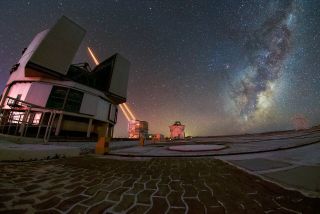
Monday, November 18, 2024: Pew! Pew! The two lasers shooting into the stars come from European Southern Observatory's (ESO's) Very Large Telescope (VLT), high in the Chilean mountains. The lasers create artificial "stars" in Earth's upper atmosphere. VLT then uses those stars as reference points to help the telescope's computer correct for atmospheric distortion. The VLT lasers create these reference stars through the interaction of the beams' photons with sodium atoms that reside at about 55 milers (90 kilometers) in altitude, causing them to glow.
A wave of aurora
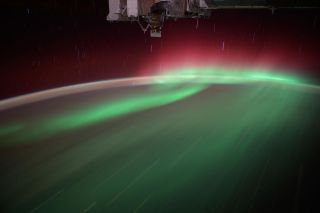
Thursday, November 14, 2024: As the sun's solar cycle continues through its maximum phase, beautiful aurora are increasingly smeared across the Earth's skies, and while the hypnotic swirls of greens and reds can enchant from the surface, they are equally astounding when viewed from above. In this case, from the International Space Station (ISS).
NASA astronaut Don Petit, well known for his stunning photography from space, snapped this photo from the ISS while passing over Winnipeg. Below, the red-crowned green aurora streak across Earth's atmosphere, with the stars stretched from camera exposure above.
Banana for scale.

Wednesday, November 13, 2024: SpaceX is gearing up for the sixth test flight of its Starship megarocket, which is now less than a week away. The sixth Starship vehicle's 165-foot-tall (50-meter-tall) upper stage was rolled out to the launch pad at its Starbase site in South Texas for testing ahead of the planned Nov. 18 liftoff. SpaceX documented the milestone on X, posting this and two other photos of yesterday's move.
One of the photos is a closeup that focuses on some colorful artwork adorning the stainless-steel spacecraft — a pixelated, smiling cartoon banana holding a relatively realistic banana. — Mike Wall
Read more: SpaceX rolls Starship spacecraft to pad ahead of Nov. 18 launch (photos)
Galaxies tangled in 'the queen's hair'

Tuesday, November 12, 2024: The Hubble Space Telescope has captured two tangled galaxies, whose interactions have caused knots to form in the "queen's hair."
The galactic duo, formally known as MCG+05-31-045, is located 390 million light-years away in the constellation Coma Berenices, which means "Berenice's Hair" in Latin and refers to Queen Berenice II, a ruler of Ptolemaic Egypt more than 2,000 years ago. The larger elliptical galaxy is pulling material from a smaller neighboring galaxy, distorting its spiral arms. — Samantha Mathewson
Read more: Galaxies get tangled up in 'the queen's hair' in new Hubble Telescope image
Juno captures Jupiter's beauty
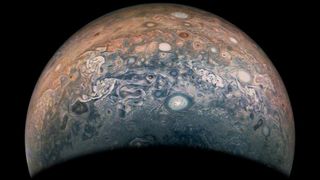
Monday, November 11, 2024: NASA's Juno spacecraft has sent back stunning photos of Jupiter, including colorful, chaotic storms swirling through the planet's atmosphere. The raw photo data captured by the spacecraft's JunoCam during a recent flyby was processed by citizen scientists using color-enhancing filters to highlight Jupiter's beauty.
The photos, shared on the mission's website, reveal intricate details of Jupiter’s stormy atmosphere, including colorful bands, turbulent cloud patterns and powerful vortices, both big and small. Citizen scientists working with the raw image data, which is available to the public online, increased the contrast of the images captured in visible light to emphasize the planet's striking color variation. — Samantha Mathewson
Read more: Jupiter's storms and its 'potato' moon Amalthea stun in new NASA Juno probe images
Mesmerizing Moai Milky Way views
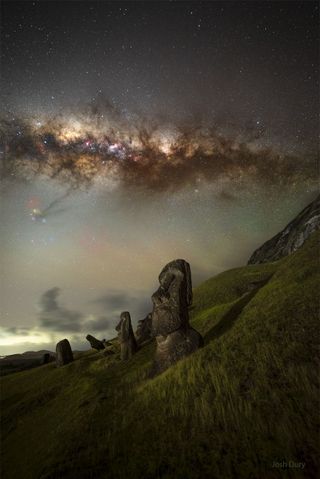
Thursday, November 7, 2024: When photographer Josh Dury traveled to Easter Island for last month's annular solar eclipse, he wasn't going to let a single moment go to waste. Although primarily there for the eclipse, Dury also managed to capture some images overnight, with some of the island's famous statues, known as Moai.
"In native Rapa Nui language, 'Aringa Ora O Te Tupuna' translates to English as 'The Living Face of the Ancestors'. I believe this phrase encapsulates the bridge between art, science and culture as well as the importance of astronomy to the Rapa Nui people," Dury said.
Your home as far away from home as possible

Wednesday, November 6, 2024: Ever feel like getting away? Like, as far away from Earth as possible? The moon is the furthest any human has ever gone. So, if recent events have you suddenly longing to yeet yourself off the planet for a better life elsewhere, the moon isn't the absolute worst place to aim.
That's exactly what NASA is doing. For the first time since the Apollo missions in the 1960s and 70s, the U.S. space agency is planning to send astronauts back to the moon. With NASA's Artemis Program, the space agency is hoping not only to reignite an era of lunar landings, but to stay on the moon, and in orbit around it, for long-term missions. Enter the Gateway space station. NASA's lunar Gateway will orbit the moon and serve as a waypoint between launching from the Earth and landing on the moon.
Pictured here, Gateway's Habitation and Logistics Outpost (HALO) module, where astronauts will live and work between excursions to the lunar surface. HALO is being constructed by Northrop Grumman and Thales Alenia Space in Turin, Italy, where it recently completed a major static load test. The module is about the size of a small RV, so if you don't mind some cramped quarters and really want to leave Earth in the rearview mirror, keep your eyes out for the next time NASA opens astronaut applications.
"What matters is that you vote!"

Tuesday, November 5, 2024: "It doesn’t matter if you are sitting, standing, or floating - what matters is that you vote!"
That's what NASA astronaut Nick Hague posted to X this morning, from the International Space Station. All four American astronaut managed to cast their absentee ballots from space, and if they can vote from space, you can sure make it to your polling locations. Today's the day! Go vote!
Read more: How do you vote from space? NASA astronauts cast 2024 election ballots from ISS
Related: Why can't active NASA astronauts endorse US presidential candidates?
Astronaut shoots a shadowy Dragon

Monday, November 4, 2024: NASA astronaut Don Pettit snapped this ghostly photo of SpaceX's Crew Dragon Freedom docked at the International Space Station. The black-and-white image shows the belly of the Dragon, including windows with filters on board to lessen the bright sun. "I like how the sun shines through the stitching, personifying the composition," Pettit wrote on social media. — Elizabeth Howell
Read more: NASA astronaut snaps spooky photo of SpaceX Dragon capsule from ISS
Martian solar eclipse
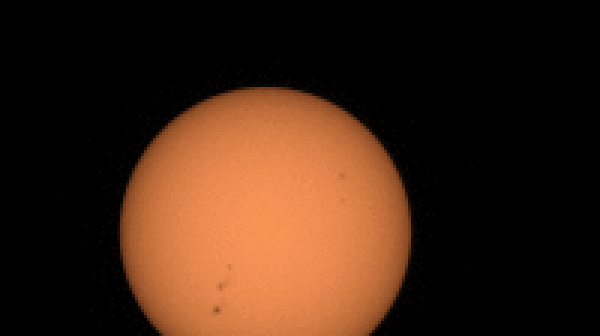
Friday, November 1, 2024: NASA's Perseverance Mars rover was treated to a "googly eye" solar eclipse as the planet's moon Phobos passed in front of the sun.
Phobos — one of Mars' two moons, along with the even tinier Deimos — traveled between the Red Planet and the sun on Sept. 30, the 1,285th Martian day of Perseverance's mission. The rover, located on the western wall of Mars' Jezero Crater at the time, captured the eclipse using its powerful Mastcam-Z camera system. — Samantha Mathewson
Read more: Perseverance rover watches 'googly eye' solar eclipse from Mars (video)
Archives
Check out our Image of the Day Archives for more awesome photos.
Image of the Day 2020 Archive

Image of the Day 2019 Archive
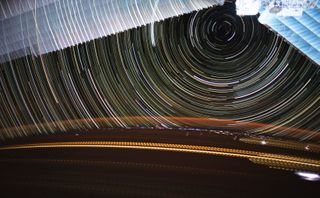
Can't find the date you're looking for? It may have been a weekend or holiday, when we don't normally update our Image of the Day.
Click 'NEXT PAGE' below for October >
October >
Join our Space Forums to keep talking space on the latest missions, night sky and more! And if you have a news tip, correction or comment, let us know at: community@space.com.

Space.com is the premier source of space exploration, innovation and astronomy news, chronicling (and celebrating) humanity's ongoing expansion across the final frontier. Originally founded in 1999, Space.com is, and always has been, the passion of writers and editors who are space fans and also trained journalists. Our current news team consists of Editor-in-Chief Tariq Malik; Editor Hanneke Weitering, Senior Space Writer Mike Wall; Senior Writer Meghan Bartels; Senior Writer Chelsea Gohd, Senior Writer Tereza Pultarova and Staff Writer Alexander Cox, focusing on e-commerce. Senior Producer Steve Spaleta oversees our space videos, with Diana Whitcroft as our Social Media Editor.
-
rod ReplyThe Exoplanets Channel said:The images are truly breath-taking.
The Exoplanets Channel, what star and reddish exoplanet is shown in your picture, looks like about 8" angular separation? I use this site as my canonical reference to exoplanets, The Extrasolar Planets Encyclopaedia Currently 4150 exoplanets are listed. -
swiggly ReplyThe Exoplanets Channel said:The images are truly breath-taking.
My Comet Image:
Neowise -
rod Reply
This is a very good image here. In enjoyed some recent views of NEOWISE using my 90-mm telescope at 40x early, shortly after 0415 EDT. Bifurcated tail obvious too.swiggly said:My Comet Image:
Neowise -
Helio The IOD image for yesterday of the Veil nebula is stunning! The graphics are such that it's almost as if it has an oil film on top. It has both 3D and texture feel to it.Reply -
Astro.Letizia I hope they start posting these daily again! I always start my day off with the newest image but it's been a couple of months now :(Reply